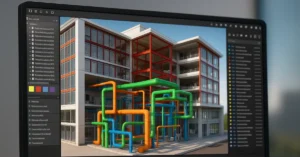Discover the underrated brutalist buildings in Bangalore
Bangalore, often hailed as the Silicon Valley of India, is globally recognized for its IT boom, lush green spaces, and a thriving cosmopolitan culture. Yet, hidden in the shadows of tech parks and modern skyscrapers lie raw, bold, and fascinating relics of a different era—brutalist buildings that defy decorative trends in favor of functionality and raw expression.
Brutalism, with its massive concrete blocks, exposed materials, and geometric shapes, found its way to Bangalore in the post-independence era. The city, known for its openness to experimentation and innovation, became a breeding ground for modernist and brutalist architecture during the 1960s to 1980s. These buildings, while often overlooked, tell stories of cultural shifts, urban planning, and architectural courage.
This blog explores the most compelling brutalist buildings in Bangalore, diving deep into their history, architectural relevance, and cultural symbolism.
What is Brutalism and How Did It Reach Bangalore?
Brutalism emerged in Europe after World War II, born from the need for affordable housing and public buildings. Derived from the French term “béton brut” (raw concrete), brutalist architecture emphasizes strength, utility, and an unfiltered expression of materials.
In India, brutalism took root as the nation underwent rapid urbanization post-independence. Architects like Le Corbusier, who influenced the design of Chandigarh, laid the groundwork for modernist movements. Bangalore, then a peaceful garden city, began transitioning into a metropolitan hub, and with that came a need for institutional, educational, and government buildings—the perfect setting for brutalist expression.
Top Brutalist Buildings in Bangalore
1. Indian Institute of Science (IISc) Buildings
Location: Malleshwaram, Bangalore
The newer blocks within the Indian Institute of Science campus feature strong brutalist tendencies. Built during the institution’s mid-century expansion, these buildings have clean geometric lines, rigid concrete frames, and minimal ornamentation. They embody functionality, focusing on research utility rather than aesthetic flair. The integration of lush landscaping around stark concrete makes the contrast even more visually impactful.
2. Bangalore University Buildings
Location: Jnana Bharathi Campus
Constructed in the 1970s and 80s, several departments of Bangalore University display textbook brutalist architecture. Characterized by long concrete corridors, angular projections, and solid columns, the structures reflect the aspirations of a growing academic institution and the ideals of accessibility and strength. These buildings still serve thousands of students every day.
3. Indian Space Research Organisation (ISRO) Campus
Location: Old Airport Road, Bangalore
While the ISRO campus is not publicly accessible in its entirety, its office buildings are unmistakably brutalist. The unadorned concrete façades, horizontal and vertical planes, and deep overhangs are purpose-built for climate control and durability. They express a powerful narrative of India’s journey toward scientific independence, all encased in raw concrete.
4. Karnataka State Library (City Central Library)
Location: Cubbon Park
This massive library building within Cubbon Park, constructed in the 1980s, leans toward brutalist sensibilities. Although it features a red-painted finish now, the underlying structure shows off bold, angular masses with minimal windows. Its functional design, large interior spaces, and heavy usage underline the brutalist principle of serving the masses.
5. Vidhana Soudha Annexe Building
Location: Opposite Vidhana Soudha
Though the original Vidhana Soudha is a blend of neo-Dravidian and traditional architecture, the Annexe building displays modernist and brutalist influences. With its straight lines, deep-set windows, and exposed concrete in certain wings, it presents a stark contrast to the ornate original and shows how the state embraced contemporary styles in auxiliary infrastructure.
6. HAL Aerospace Museum Structures
Location: Old Airport Road
The auxiliary buildings and viewing halls within the HAL Aerospace Museum campus bear signs of brutalist design. Functional, angular, and designed for clarity, these structures prioritize efficiency and clarity of space. The concrete motifs serve as a fitting tribute to aerospace engineering’s industrial aesthetic.
7. Public Works Department Buildings
Location: Multiple across Bangalore
Scattered across the city, several PWD buildings were constructed using a standardised architectural plan that borrowed from brutalist traditions. These buildings, built between the 1960s and 1980s, have blocky façades, minimal design detailing, and rugged material use. Though often not preserved well, they are emblematic of mid-century Indian bureaucracy and architectural pragmatism.
8. LIC Building
Location: Near Cubbon Road
The Life Insurance Corporation of India building in Bangalore is another excellent example of how commercial structures employed brutalist design in the 1970s. Its vertical frame, window layout, and rigid profile emphasize form following function. The no-nonsense look aligned with the public sector ethos of the era.
Cultural Reception and Evolving Perception
Brutalist buildings in Bangalore, much like elsewhere, have had a polarizing reception. While some consider them eyesores compared to glassy modern towers or ornate colonial-era buildings, others appreciate their resilience and honesty. They represent a time when architecture was more about purpose than prestige.
Recently, there’s been renewed interest in these structures, thanks in part to urban historians and architectural enthusiasts who see them as invaluable cultural artifacts. Instagram pages, walking tours, and student projects have started to bring awareness to these bold remnants of Bangalore’s architectural evolution.
Why These Buildings Matter Today
Preserving brutalist buildings is not just about maintaining concrete; it’s about keeping intact a record of the city’s transition from a sleepy town to an academic and technological hub. These structures were built to serve the public efficiently and cheaply while still projecting strength and authority. Their very existence challenges us to rethink what is beautiful in a city.
As Bangalore faces challenges like rapid urbanization, ecological imbalance, and cultural homogenization, brutalist buildings serve as silent reminders of simpler priorities: utility, durability, and accessibility.
Threats and Challenges to Preservation
Unfortunately, many of these buildings are under threat due to neglect, redevelopment pressure, and a lack of public awareness. As land value skyrockets in Bangalore, old government or institutional buildings are seen as prime candidates for replacement by more lucrative commercial developments.
The lack of heritage recognition for modernist and brutalist architecture further adds to the problem. While colonial bungalows and temples enjoy protected status, mid-century buildings often do not, despite being historically and culturally significant.
What Can Be Done?
- Documentation: Creating a thorough inventory of brutalist and modernist buildings in Bangalore can help raise awareness and lay the foundation for heritage protection.
- Community Engagement: Local groups and academic institutions can hold public events, exhibitions, and discussions to inform citizens of their architectural value.
- Adaptive Reuse: Rather than demolishing old brutalist buildings, developers and institutions can adapt them for modern use—converting libraries into co-working spaces or government offices into art galleries.
- Policy Support: The state government and heritage committees should broaden their definition of heritage to include architectural movements like Brutalism.
Conclusion
Brutalist buildings in Bangalore may not glitter like glass skyscrapers, but they stand as monumental markers of ambition, resilience, and an era that shaped the city’s identity. From academic institutions and government buildings to quiet concrete libraries, each structure tells a story of India’s architectural response to post-independence challenges.
As Bangalore marches into the future, it must decide whether to erase or embrace these concrete chronicles. With thoughtful preservation, creative adaptation, and a shift in public perception, the city can honor its architectural roots while continuing to innovate.
Whether you admire their boldness or critique their aesthetics, one thing is certain: brutalist buildings in Bangalore are impossible to ignore—and perhaps, finally, they are being truly seen.
If you’re interested in learning more about architecture firms in Europe, check out this comprehensive list of the top 50 firms compiled by Archgyan. From innovative startups to long-established industry leaders, this list has it all. Take a look and discover some of the most inspiring and influential architecture firms in Europe today.
If you’re interested in architecture and want to learn more about this amazing field, subscribe to our podcast on youtube
For more SketchUp tutorials, head to https://www.sketchupguru.com










